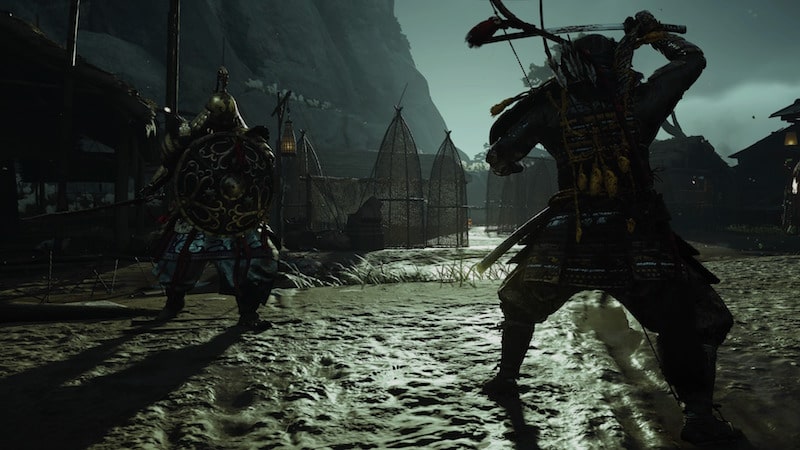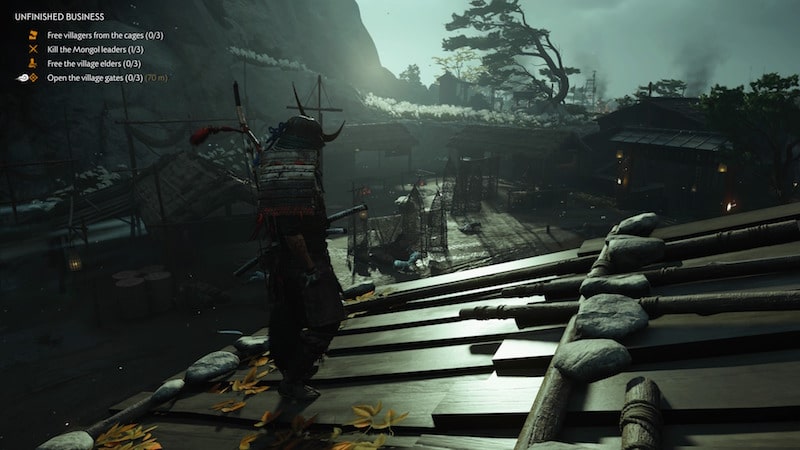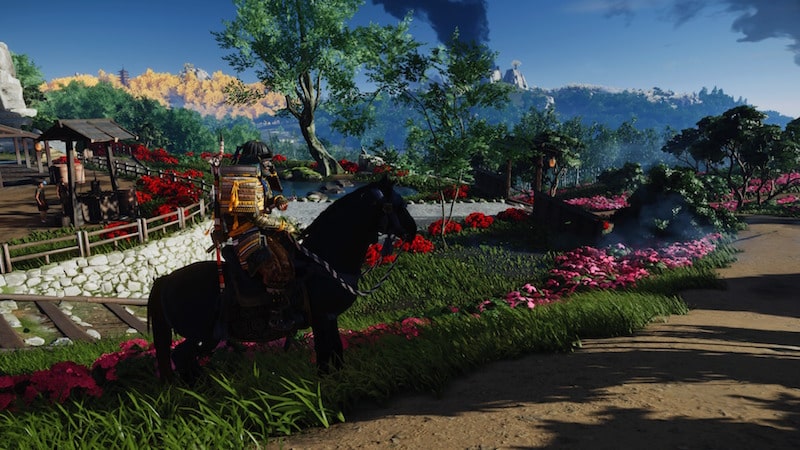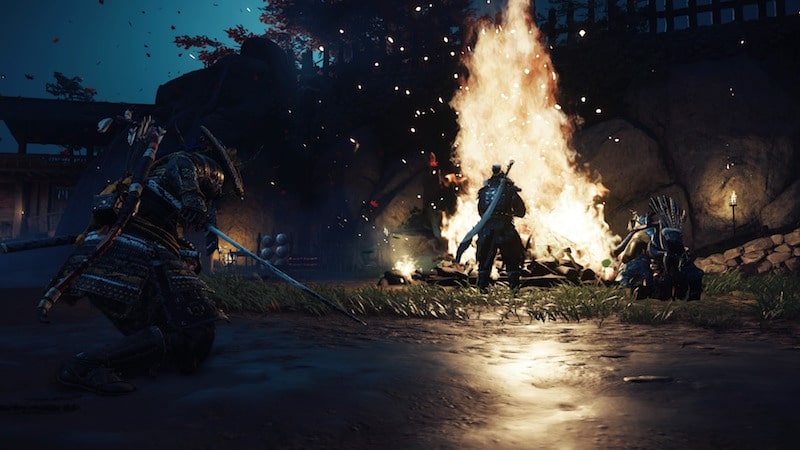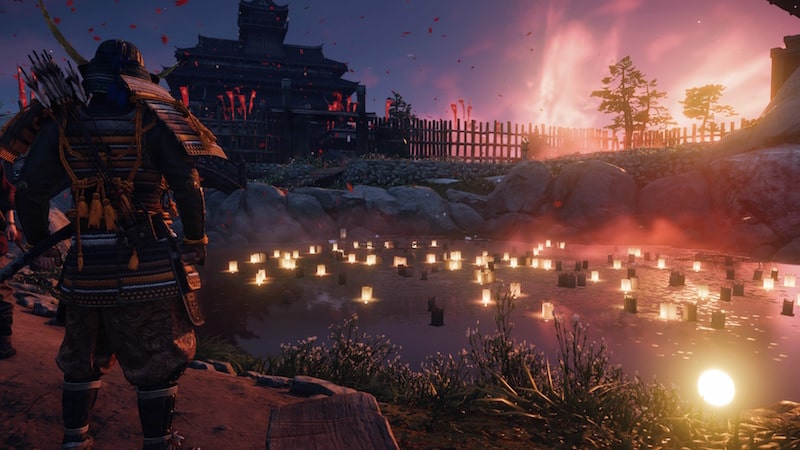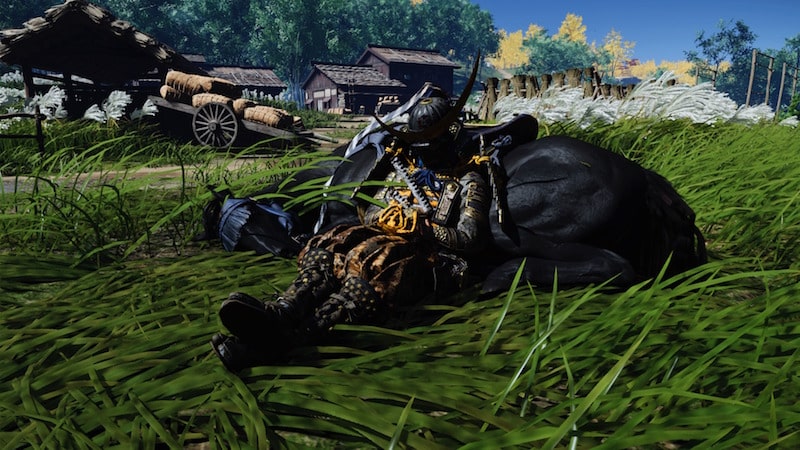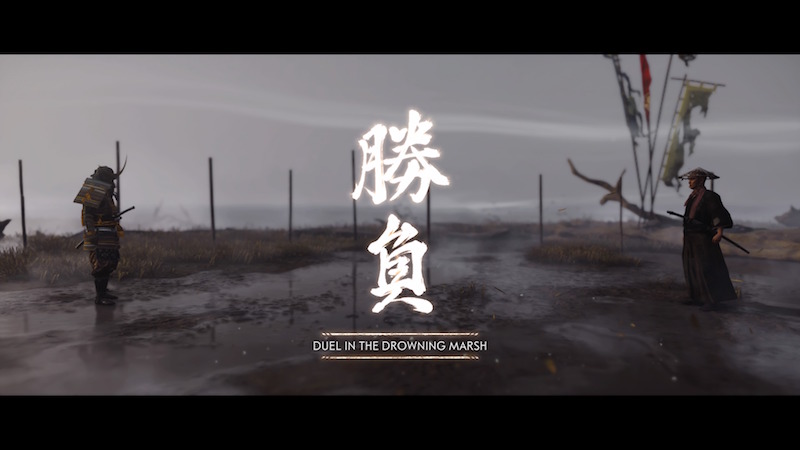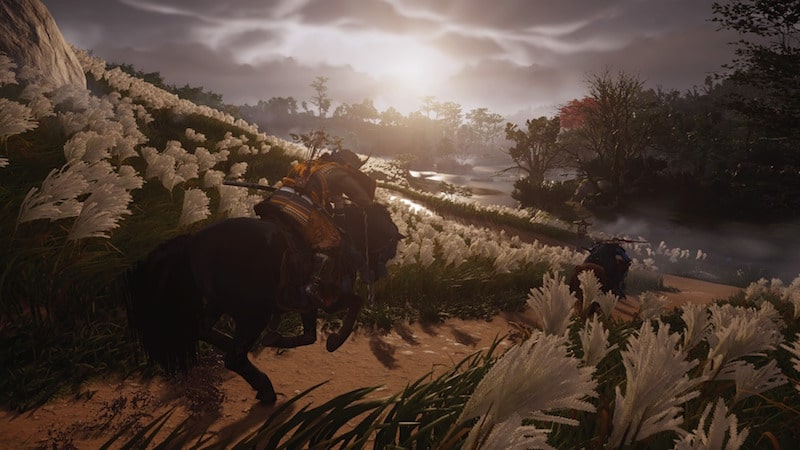Ghost Of Tsushima PS4 Review - PlayStation Universe (original) (raw)
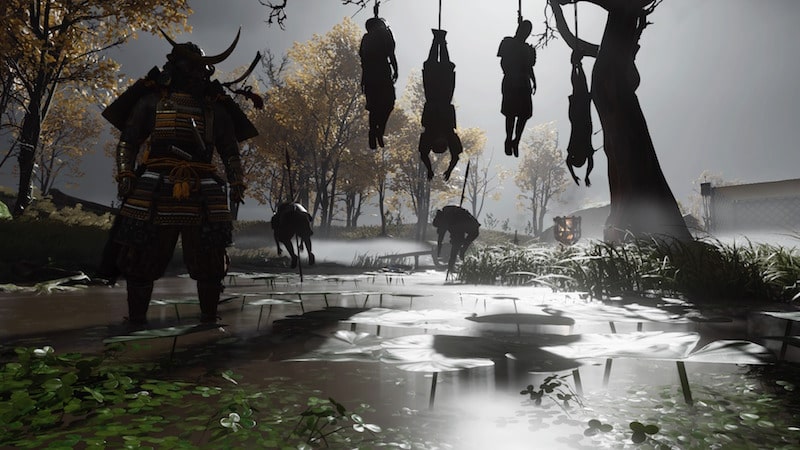
Ghost Of Tsushima PS4 Review – Look, you need to know that the combat in Ghost of Tsushima is absolutely stunning and fulfilling in ways that other developers just haven’t been able to quite master. It’s simply brilliantly empowering stuff that makes you feel like a Samurai and yet, beyond such seemingly surface fulfillment and being a reliable metric for any action adventure romp worth its salt, it serves Sucker Punch Productions‘ deeper ambition to fashion the sort of relatively po-faced, fantasy-free video game take on Samurai cinema that has been sorely missing for a while now.
Ghost of Tsushima PS4 Review
A Rip-Roaring, Heartfelt Samurai Epic Set In A Familiar Open World Framework
As a sprawling adventure that brazenly wears its Samurai cinema inspirations on its digital sleeve, Ghost of Tsushima succeeds grandly both as an ode to the classic movies and also as a compelling, character driven odyssey on its own terms. As Jin Sakai, the young heir to the well-respected Sakai clan of Samurai, players must cut a vengeful bloody swathe across the island of Tsushima as Jin seeks to repel the Mongol invaders, avenge his murdered family and restore honor to his clan. It’s the sort of classic yarn that fans of Akira Kurosawa and his legendary lead actor, Toshiro Mifune, will warmly recognize and embrace.
Combat in Ghost of Tsushima is some of the very best I have ever experienced and does ample justice to its Samurai cinema roots.
Arguably nowhere is this commitment to getting the aesthetic and feel of Samurai cinema right better epitomised than in the Kurosawa Mode. Officially signed off and endorsed by the Kurosawa estate, Kurosawa Mode not only decks out the game in a monochrome filter and ramps up the wind and ambient natural effects (honestly, you’ve never seen so many falling petals in your life), but it also strives to emulate many of the more nuanced filmmaking techniques that the legendary Japanese auteur employed during his heyday too, such as a curved lens, reduced FOV and more.
Once into the game proper and akin to a Samurai reflecting upon the rigours of his life through an elegant Haiku poem, it’s certainly fair to say that Ghost of Tsushima demands your patience, at least initially. Split into three acts which correspond to a portion of Tsushima Island turn, Sucker Punch’s latest certainly takes a little while to get going and in its first act, struggles to distance itself from the distinctly shopworn open-world template that Ubisoft has so reliably recycled over the years.
Related Content – Best PS4 Exclusives – Amazing Games That Everyone Should Play
There’s no getting away from it – Ghost of Tsushima is very much a contemporary open world adventure and with it, carries a lot of the design baggage that have served to inflict a kind of fatigue upon those in which the novelty of venturing from point to point and indulging in the same gameplay loop has since worn thin. As a direct result, though Ghost of Tsushima does employ some wrinkles to distinguish itself from seemingly similar offerings, how you feel about it will ultimately depend on how much you love Samurai cinema and whether or not that will be enough to mitigate being saturated with open world games as we currently know them.
When attacking an enemy camp, outpost or fort, though the act in itself is repetitive, you have a number of different approaches to take which helps to keep things interesting.
As such, you can expect to run a broadly similar and familiar gamut of activities that you might see anywhere else, such as clearing out enemy outposts, collecting craftable ingredients, reaching hard to reach areas for precious loot, attacking roaming foes and more besides. That said and as mentioned previously, Ghost of Tsushima does have a few tricks up its patterned sleeve to freshen the formula up a little. The first and most widely known of these is the Guiding Wind mechanic, which pushes the player towards known objectives or, if no objective has been specified, another point of interest that might be close by.
Another neat bit of design that Sucker Punch have wrought here is the manner in which they deal with the game world map. A world away from Assassin’s Creed Odyssey’s clutter-orgy of icons, Ghost of Tsushima instead employs a fog of war style approach with its map, where new areas, locations and activities only appear as you physically make your way into that area. In practice, this makes the idea of tackling the game’s wealth of side quests, activities and collectibles far less intimidating than it otherwise would be, whilst also encouraging freeform exploration. Other developers thinking of designing open world experiences of this ilk should take notice.
In terms of those activities which are dotted around each of the three maps, Ghost of Tsushima largely does a good job of incentivising the player to spend the time necessary to find and complete them. Hot springs provide Jin with a boost to his maximum health, while bamboo stacks allow our hero to top up his Resolve (more on this in a bit), which aids his success during combat. Elsewhere, though the numerous shrines in Tsushima provide handy charms to buff Jin’s abilities, it’s really in the Tomb Raider esque platforming style challenges that these side activities prove to be the most compelling.
Ghost Of Tsushima’s Combat Feels Endlessly Satisfying And Is An Authentic Love Letter To Samurai Cinema
Of course, this being a game about Samurai and Mongols and many, many sharp swords, there’s a whole heap of combat in Ghost of Tsushima and happily, I can report that it is among the best I have ever experienced. Indeed, what’s surprising about Ghost of Tsushima’s combat is just how layered it all is.
Ghost of Tsushima is easily one of the most visually opulent open world adventures money can buy.
Tapping directly into the veins of classic Samurai action, players are given an option to confront their enemies head-on with a ‘stand-off’, where like a gunslinger tickling the hilt of his gun in anticipation of a quick draw, Jin lightly holds onto the handle of his sword in preparation to deal with an on-rushing foe. By releasing the triangle button at just the right time, Jin can get an instant kill and by placing the appropriate points in the right skill tree, he can extend that streak further still to multiple enemies, often laying waste to a small group of bad dudes in seconds.
Despite how shallow the standoff mechanic seems, there is a fair chunk of a nuance to it too. While less hardy foes will blindly rush you and be cut down like swaying corn stalks, more competent adversaries will not only be much faster in attacking you, but they’ll feint too in an attempt to get you to draw prematurely, causing you to lose massive amounts of health in the process.
When you nail a perfect standoff and vanquish multiple foes with a single strike each, the feeling of satisfaction is absolutely incredible and more than that, winning at a standoff also sets you up well for the conflict ahead as it is fully restocks your resolve, too. Honestly, it’s the sort of stuff that after watching the likes of Seven Samurai, Yojimbo and Mifune’s Miyamoto Musashi Samurai Trilogy, I thought we would never see realized in a video game in this sort of fidelity, and yet here we are. Sucker Punch Productions are in fact magicians, it would seem.
Ghost of Tsushima feels like the Tenchu remake that we never got. I’m not even joking.
Once the fight kicks off properly, it isn’t long before you settle into the flow of Ghost of Tsushima’s moment to moment combat. In a fashion not dissimilar to FROM Software’s Sekiro: Shadows Die Twice, there is a premium placed on parrying, with a perfectly counterattack at the correct time dealing an unholy amount of hurt to your enemies that often results in an instant kill.
There’s a trick to this though. While regular attacks can be countered, some enemies will attempt to strike Jin with highly damaging attacks in which the window for a counter is extremely small, as evidenced by a silver-blue glint coming off their weapons. Equally, many enemies have unblockable attacks too, requiring Jin to do an evasive roll or backwards hop in order to avoid serious damage and it’s in the later enemies which mix up all of these attacks that the player is presented with a true challenge.
Another design element that Ghost of Tsushima shares with Sekiro is the stagger mechanic. Here, if Jin pressures a foe sufficiently with a steady stream of attacks, he can break through their guard and start doing real damage to them. Where things get a little more complicated though is in the multiple stances that Jin can use, since each enemy can only really be properly staggered if you’re in the correct stance. It takes some getting used to for sure, but in the heat combat switching between each of the four stances mid-flow can be super satisfying also.
Almost every scene in Ghost of Tsushima is absolutely photo mode worthy.
In keeping with its dyed in the wool Samurai cinema stylings, Ghost of Tsushima leans into the romanticism of the genre with its highly intense duel scenarios. Subtle, spectacle stuffed encounters where players must overcome a singular and extremely challenging foe, these duels unfold against the often idyllic backdrop of a shower of blossoms, against a waterfall and just about every other classic Samurai duel setting you can think of.
Ironically, Ghost Of Tsushima Feels Like The Closest We’ll Ever Get To A New Tenchu
As much as Jin wants to be an honorable Samurai and a credit to his clan, he soon realizes that in order to defeat the Mongol hordes who abide by no such code, he must try and win by any way he can – regardless of how it affects his code of honor (more on that later). In practice, this results in Jin being able to employ a number of tricks and gadgets during battle in addition to his trusty katana.
From using bows, quickly flung kunai, black powder bombs and much more, Ghost of Tsushima presents players with a surprising number of creative ways to end the fight – though such tricks are not available in the otherwise honorable duels, for obvious reasons. Beyond such tools and shortcuts and by completing the corresponding side quests, Jin can also learn a series of ‘mythic techniques’ that are super devastating unblockable attacks, but the use of each one consumes his resolve and it’s here that Ghost of Tsushima reveals another layer of its sophisticated combat system.
Resolve is essentially a finite resource that can be used to heal Jin or to use the aforementioned mythic techniques, but in doing so, the player must consider how best to use it during a fight; creating a neat risk/reward dynamic in the process. To replenish his resolve, Jin can successfully complete a standoff, defeat foes in combat or assassinate enemies – and it’s that last point which brings us to the polar opposite of Ghost of Tsushima’s confrontational combat mechanics.
Ghost of Tsushima supports both performance and resolution graphics modes on PS4 Pro.
Brilliantly, you can avoid direct confrontation altogether and go full ninja if you want; silently stalking the Mongol horde from the rooftops before dropping down upon them with an airborne assassination, or carving your way through a group of them with a chain assassination technique. Certainly, when you’re sprinting across rooftops, crawling under huts, silently killing enemies with blowpipes and generally being something of an horrific ninja bastard, Ghost of Tsushima starts to feel like the Tenchu remake that we never got.
Ghost Of Tsushima’s Plot And Characters Are Stoically Stuffy, But Expectedly So
At the core of Ghost of Tsushima’s narrative is the notion that honor is paramount and that no matter how bad the Mongol forces are (spoiler – they’re very, very bad), a Samurai should never give up that code regardless of the adversity standing before him. Instead, a Samurai should face every enemy head-on and not stoop to using subterfuge or any other kind of clandestine approach in order to win the day and it’s that very same system that Mongols turn against the Japanese; exploiting their unwillingness to do what is necessary in order win.
Jin, who studied the Samurai code extensively under the rigidly traditional Lord Shimura, who not only doubles up as his uncle but also as the former ruler of Tsushima, finds himself at odds with his upbringing, the man he wants to be and everything he must do in order to ensure the survival of his people. And it’s here, in that thunderous conflict between tradition and necessity that Ghost of Tsushima forms a ruthlessly efficient storytelling hook, as Jin must turn his back on everything he’s ever known in a heart-wrenching attempt to break the back of the Mongol invasion.
Ghost of Tsushima’s duels are not only great fun, but also lovingly evoke the Samurai cinema setting that Sucker Punch nail so very well in every aspect of the game’s presentation.
Beyond its central theme, the cast of characters in Ghost of Tsushima are a largely stoic and stuffy lot – though that’s to be expected. From honourable Samurai, to roguish thieves, coarse ronin and even half dunk/half insane sake merchants, it’s certainly fair to say that Ghost of Tsushima gleefully plumbs the depths of Samurai cinema character archetypes. Though again, this serves to dovetail nicely into Sucker Punch’s ambition to create a video game ode to the Samurai cinema classics of yesteryear – and it’s an ambition that the Washington based studio pulls off with commendable verve and aplomb.
Indeed Jin himself feels like an amalgam of classic Samurai cinema heroes, at once coming across with all the fire of Mifune’s Sanjuro, while at the same time extolling the humble stoutness of Hiroyuki Sanada’s Twilight Samurai. He’s an eminently likeable sort who strives to do the right thing but finds himself in conflict with his traditions and beliefs at every turn – fashioning him into quite the unexpectedly compelling protagonist in the process. Something else that should be keenly noted is just how refreshing it is to have a Samurai game that plays it straight and avoids letting fantasy elements bleed into either its design or story. More of this please.
Sucker Punch Productions Latest Is A Feast For The Eyes
Ghost of Tsushima is also a fantastically and handsomely made effort too. Though it follows so soon after the stellar technical showcase of The Last of Us Part 2, comparisons with Naughty Dog’s latest are perhaps unavoidable but are also deeply unfair as the two PS4 exclusives each have very different visual design goals. For a start, Ghost of Tsushima renders a massive open world and it does so in slavish service to the Samurai cinema setting that Sucker Punch strives so very hard to emulate.
And what a beautiful world it is too. There is a scene early on where two Samurai face off in a makeshift arena as red maple leaves gently shower and scatter everywhere according to the frenzied footwork of the combatants, while the superb lighting and shadowing work that Sucker Punch have done with the game make practically every second a photo capture worthy moment. Whether it’s Jin galloping on his horse through a swaying sea of pampas grass, or quietly writing a haiku while the sun slowly sets, bathing the world in a gold-copper glow, Ghost of Tsushima excels at creating these sorts of natural showcases like no other title out there.
In motion, Ghost of Tsushima looks absolutely stunning.
On the flipside, the character models don’t quite equal the jaw-dropping world that they exist in. While Jin and other major characters are detailed nicely enough, less important characters are not. Another slightly disappointing blemish to Ghost of Tsushima’s visual presentation is that the lip syncing is engineered around the English dub, rather than Japanese audio, which if you’re playing the game in the other wise super authentic Kurosawa mode, is a touch disappointing as it detracts a touch from the overall keenly felt sensation of authenticity.
At well over 50 hours long and depending on the depth of your open-world fatigue, so too will your opinion of Ghost of Tsushima similarly oscillate. Ably mitigated by my own boundless affection for Samurai movies and the riffs on the iconic auteurship of Kurosawa and his genre contemporaries, I was able to quite happily look past the more shopworn aspects of Ghost of Tsushima’s open world design DNA simply on account of just how thoroughly Sucker Punch have managed to nail the look, sound and feel of the setting.
With the combat being truly best in class stuff too, in addition to the surprisingly compelling story and cast of characters, there is a lot to love about Ghost of Tsushima, but ultimately your mileage will vary on your saturation of the open world design that is threaded through every aspect of its creation. For me though? Ghost of Tsushima is the fantasy-free, Samurai Tenchu hybrid with the sort of absolutely heart-stopping, fist-pumping ending that I’ve been waiting so long for. Here’s hoping that this is the last time we see this sort of standard open world template though, because as Jin himself soon discovers, often it’s best to just move on and evolve.
Ghost of Tsushima releases exclusively on PlayStation 4 on July 17, 2020.
Review code kindly provided by SIE.
